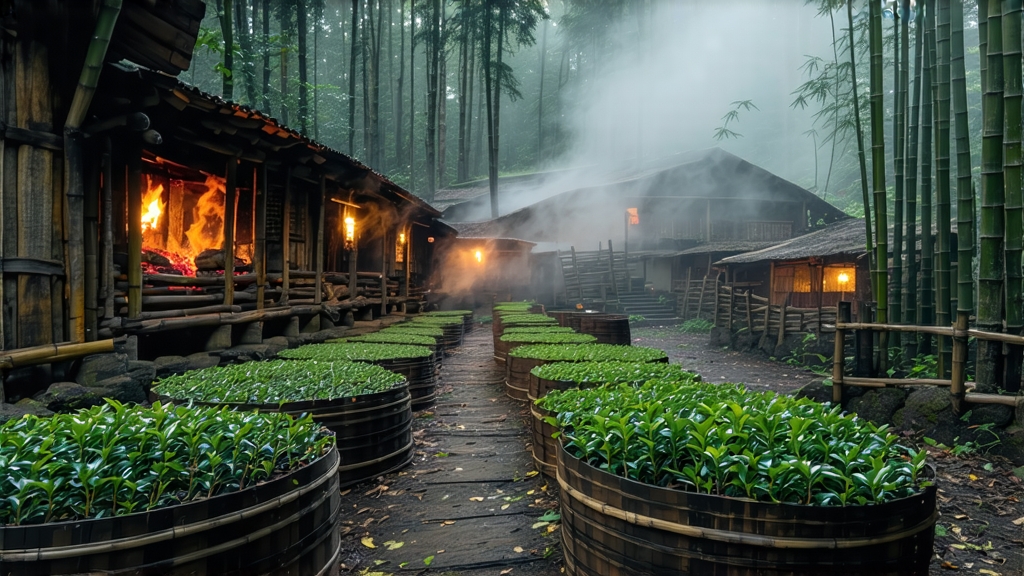
If every cup of black tea tells a story, Lapsang Souchong whispers the very first chapter. Grown in the granite crevices of the Wuyi Mountains in China’s Fujian Province, this rugged leaf was the black tea that astonished 17th-century Dutch and British merchants, launching a global obsession that would redraw trade routes and topple dynasties. Today, when sommeliers speak of “terroir-driven” teas, they are often unconsciously echoing the flavors first captured in a Wuyi cliff-garden centuries ago: resinous pine, longan fruit, and the scent of a campfire that refuses to die.
History: From Misty Crags to London Coffeehouses
Local legend claims the original smoking accident happened during the late Ming dynasty, when Qing soldiers commandeered a village tea factory. To dry the leaves quickly before the army returned, farmers spread them over pine fires. The improbable result—an intensely aromatic tea—reached the port of Xiamen, sailed past Malacca, and arrived in Amsterdam in 1604 labeled “bohea,” a corruption of “Wuyi.” English diarist Samuel Pepys drank it in 1660, calling it “a China drink of which I never had drank before.” By the 1840s, Lapsang Souchong had eclipsed green tea in London auctions, and its price per pound surpassed that of top-grade claret. The East India Company, desperate to replicate it, smuggled tea makers to Darjeeling and Assam, effectively seeding the Indian black-tea industry. Thus, every modern breakfast blend—from English to Irish—carries a whisper of Wuyi smoke in its DNA.
Two Faces of the Same Leaf: Traditional Smoke vs. Craft Fruity
Purists divide Lapsang Souchong into two stylistic lineages. The “traditional” version, still produced in Tongmu Guan, a protected enclave inside the Wuyi National Nature Reserve, is withered over local Masson pine fires, pan-fired in iron woks, rolled by hand, oxidized in bamboo baskets, then hot-smoked again in wooden chambers lined with damp pine planks. The result is a tar-black strip that smells like a pine-tar soap crossed with burnt caramel.
In the 2000s, a handful of Tongmu artisans responded to international complaints about “liquid barbecue” by creating an unsmoked—or “craft fruity”—style. They wither leaves in heated rooms circulated with warm air, oxidize them slowly at 26 °C, and bake them over charcoal embers made from local hardwood. The cup loses the campfire note but gains the honeyed fragrance of longan, lychee, and dried rose. Both styles share the same cultivar—Xiao Zhong (small leaf) or, in higher elevations, the rare Caicong varietal whose leaves are barely 2 cm long yet packed with aromatic oils.
Craftsmanship: Where Fire Meets Flesh
Timing is merciless. Picking occurs only between Qingming and Grain Rain, when two leaves and a bud still wear their spring down. The leaves must reach the factory—often a three-hour hike down narrow stone steps—before dusk. Withering begins within minutes: bamboo racks suspended over pinewood fires maintain 28–32 °C, drawing moisture while infusing smoke. After 8–10 hours the leaves, now as supple as glove leather, are hand-pressed in 200-year-old woks kept at 200 °C for exactly 108 seconds; one missed heartbeat and the batch turns bitter. Rolling follows, a 20-minute dance of wrist and forearm that ruptures cell walls, releasing catechins and enzymes. Oxidation is conducted in oak-lined baskets tucked into stone alcoves; humidity hovers at 85 %. The final smoking, called “la xun,” uses 40-year-old pine roots whose resin has crystallized into amber. The roots smolder at 80 °C for six hours, polishing the leaf with a glossy, sappy film that locks in aroma for decades.
Terroir in a Sip: Tasting Notes
Professional cupping reveals three aromatic waves. The dry leaf gives pine tar, cinnamon bark, and a trace of camphor. The first infusion (95 °C, 5 g in a 120 ml gaiwan) opens with a burst of sweet smoke reminiscent of lapsang-infused single-malt whisky, followed by black cherry and a cooling menthol finish. The second steep